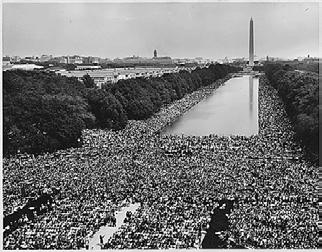
2 minute read
Baldwin and the Civil Rights Movement
Baldwin & The Civil Rights Movement
The civil rights movement mainly took place during the 1950s and ‘60s as Black Americans, almost 100 years after the abolition of slavery, mobilized and began an unprecedented fight for equality in the face of continued discrimination. Even after many Black men and women served in World War II, including the Tuskegee Airmen, the first Black military aviators in the U.S. Army Air Corps, Black veterans returned home to be met with prejudice. The 1950s saw historical moments like the U.S. Supreme Court’s Brown v. Board of Education ruling making segregation in public schools illegal (1954), Rosa Parks refusing to give up her seat on a Montgomery bus (1955), and the Civil Rights Act of 1957, the first major civil rights legislation since the end of the Civil War.
During the early 1960s, after Baldwin had returned to the United States from France, Baldwin traveled throughout the South. During his travels, he found himself aligning with the ideals of the Congress of Racial Equality (CORE) and the Student Nonviolent Coordinating Committee (SNCC). CORE was founded in 1942 by an interracial group of students in Chicago and members of the group pioneered the use of nonviolent action in the civil rights movement, including providing advice and support to Martin Luther King during the Montgomery bus boycott. King worked with CORE into the mid1960s, when CORE adopted Black separatist policies and abandoned its dedication to nonviolence. When Baldwin went on to conduct a lecture tour of the South for CORE, Baldwin discussed his own racial ideology, one that positioned him between the “muscular approach” of Malcolm X and the nonviolent ideals of King.
Additionally, Baldwin stood alongside Lorraine Hansberry, Harry Belafonte, and other civil rights figures in a meeting with then attorney general Robert F. Kennedy where they discussed the moral implications of the civil rights movement. The meeting left most attendees feeling “devastated,” though the meeting proved instrumental in showing civil rights as a moral issue rather than a political one. Baldwin also made an appearance at the Civil Rights March on Washington on Aug. 28, 1963. Despite criticisms for his pacifist ideals, Baldwin was a crucial figure in the civil rights movement.
As the ‘60s continued, the movement faced tragedy as Malcolm X and King were assassinated. In 1965, the same year Malcolm X was assassinated, a peaceful march from Selma to Montgomery, Alabama, turned violent as protesters were beaten and tear gassed by police sent by the Alabama governor George C. Wallace. The ‘60s also saw the passing of the Civil Rights Act of 1964, Voting Rights Act (1965), and the Fair Housing Act (1968), the final legislation enacted during the Civil Rights era.
The 1963 Civil Rights March







